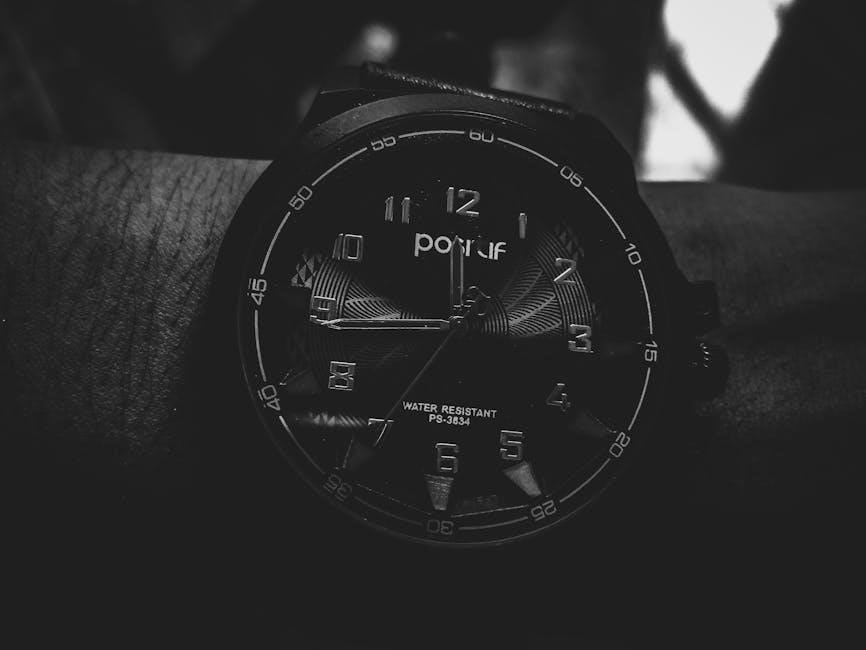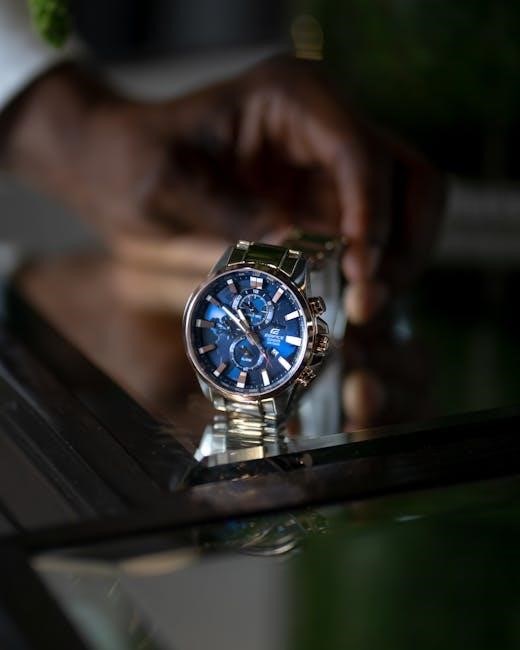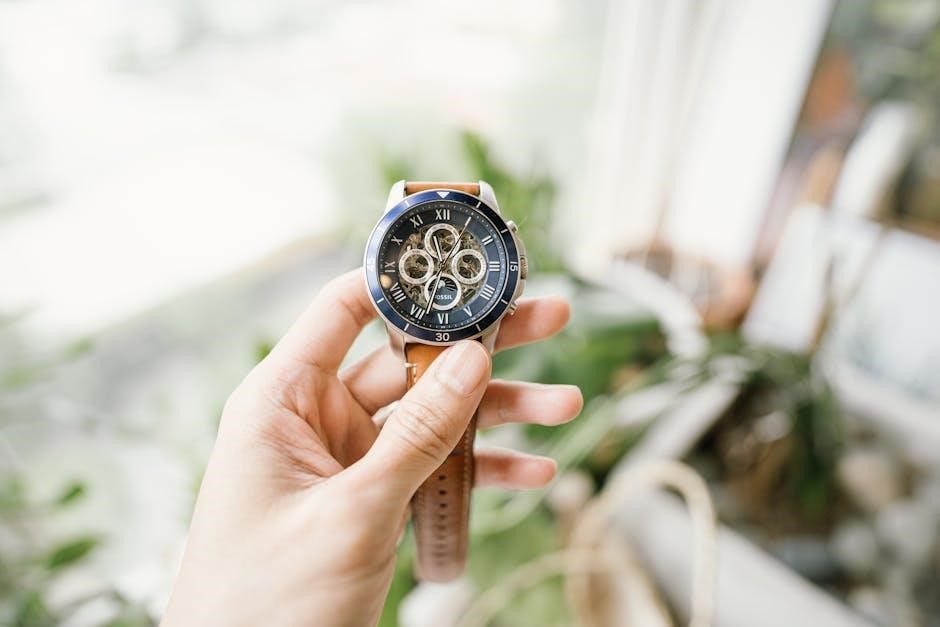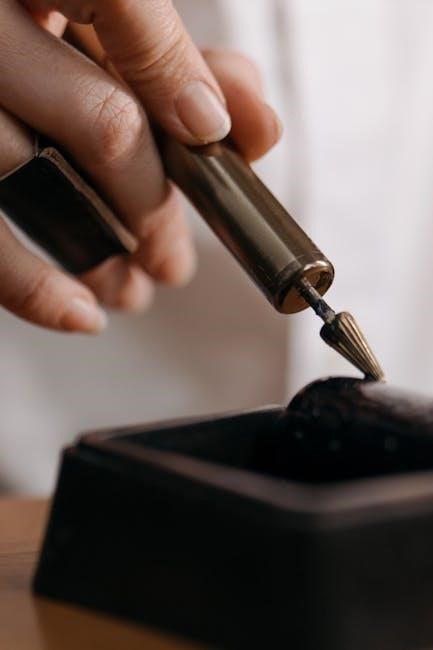
A wristwatch is a timeless accessory combining functionality and style, offering precise timekeeping while reflecting personal taste and craftsmanship. From quartz to smartwatches, they adapt to modern needs, blending tradition with innovation to remain essential in everyday life.
What is a Wrist Watch?
A wristwatch is a portable timepiece designed to be worn on the wrist, typically secured by a strap or band. It serves as a practical tool for keeping track of time and often includes additional features such as date display, alarms, or fitness tracking. Wristwatches can be powered by quartz crystals, mechanical movements, or automatic mechanisms, each offering unique advantages. Modern smartwatches even integrate with smartphones, providing notifications and app functionality. Beyond timekeeping, wristwatches are fashion statements, reflecting personal style and craftsmanship. They combine functionality, innovation, and aesthetics, making them indispensable accessories for daily life.
History and Evolution of Wrist Watches
The wristwatch has a rich history dating back to the late 19th century, evolving from pocket watches. Initially seen as a novelty, they gained popularity during World War I for their practicality. The 20th century brought significant advancements, with the introduction of quartz movements in the 1970s revolutionizing accuracy and affordability. Modern smartwatches now integrate fitness tracking, GPS, and smartphone connectivity, blending tradition with cutting-edge technology. This evolution reflects changing lifestyles and technological progress, transforming wristwatches into essential timekeeping devices and stylish accessories.
Importance of Wrist Watches in Modern Times
Wristwatches remain essential in modern life, blending functionality and style. Beyond timekeeping, they serve as fitness trackers, navigation tools, and smartphone companions. Smartwatches monitor health metrics and receive notifications, catering to active lifestyles. Their aesthetic appeal makes them fashion statements, while their durability ensures reliability. Whether for sports, formal events, or daily use, wristwatches adapt to diverse needs, offering practicality and personal expression.

Types of Wrist Watches
Wristwatches come in various types, including quartz, mechanical, automatic, and smartwatches, each offering unique features to suit different preferences, lifestyles, and technological needs.

Quartz Watches
Quartz watches are known for their accuracy and reliability, powered by a battery that drives a quartz crystal to oscillate at a precise frequency. Their low-maintenance design makes them a popular choice, as they require minimal servicing and do not need winding. With a battery life typically lasting one to two years, quartz watches are ideal for everyday wear. They are also highly resistant to shocks and extreme conditions, making them durable and practical. Available in a wide range of styles, from casual to luxury designs, quartz watches cater to diverse preferences and budgets, offering a hassle-free timekeeping experience.
Mechanical Watches
Mechanical watches are powered by a mainspring that stores energy, transmitted through a series of gears to the watch hands. Unlike quartz watches, they do not require a battery and are wound manually or automatically. These timepieces are celebrated for their intricate craftsmanship and engineering, often featuring visible movements through transparent case backs. Mechanical watches are less accurate than quartz watches but are prized for their heritage, artistry, and emotional appeal. They are often seen as collectibles or heirlooms, with many enthusiasts valuing their mechanical complexity and the story behind their creation. Regular servicing is essential to maintain their precision and longevity.
Automatic Watches
Automatic watches, also known as self-winding watches, are a type of mechanical watch that harnesses energy from the wearer’s movements to power the timepiece. A rotor inside the watch oscillates with motion, winding the mainspring and storing energy. This eliminates the need for manual winding, offering convenience while maintaining the elegance of mechanical craftsmanship. Automatic watches are popular for their blend of practicality and horological artistry, appealing to those who appreciate tradition and engineering. They are low-maintenance, as they do not require battery replacements, and are often chosen for their smooth operation and timeless appeal in both casual and formal settings.
Smartwatches
Smartwatches are advanced wristwatches that combine traditional timekeeping with smart technology. They connect to smartphones, enabling users to receive notifications, control music, and access apps directly from their wrist. Many smartwatches include fitness tracking features like step counting, heart rate monitoring, and GPS. They often support third-party apps, allowing for customization and additional functionalities. Some models offer health monitoring, such as sleep tracking and stress level analysis. Smartwatches are ideal for tech-savvy individuals who value connectivity and convenience. They usually have touchscreens or voice command capabilities, making them versatile tools for modern lifestyles. Regular software updates keep them up-to-date with the latest features.
Key Features of Wrist Watches

Wrist watches feature timekeeping, design, and functionality, blending style with practicality. They combine accuracy, durability, and aesthetics, making them versatile accessories for everyday wear and special occasions.
Timekeeping Accuracy
Timekeeping accuracy is a critical feature of wrist watches, ensuring precise time display. Quartz watches often boast high accuracy, with deviations of just seconds per year, thanks to battery-powered movements. Mechanical and automatic watches rely on intricate gear systems, offering varying levels of precision depending on craftsmanship. Luxury brands employ advanced techniques to minimize errors, such as tourbillons or certifications like COSC. Regular servicing and proper care further enhance accuracy, as factors like temperature and magnetic fields can affect performance. High-quality watches are designed to maintain reliability over time, making them dependable companions for everyday use or special occasions.
Water Resistance
Water resistance in wrist watches refers to their ability to withstand moisture and water ingress under specific conditions. Ratings like 30m, 50m, or 100m indicate the watch’s resistance to water pressure at depths, not actual diving depths. Higher ratings suit swimming or diving, while lower ratings protect against splashes or rain. Proper sealing and gasket maintenance are crucial for preserving water resistance. Exposure to extreme temperatures, chemicals, or impacts can compromise this feature. Regular servicing ensures the watch remains water-tight, making it durable for both everyday wear and water-related activities. Always check the manufacturer’s guidelines for specific water resistance capabilities and limitations.
Additional Functions (Chronograph, GPS, etc.)
Modern wrist watches often feature additional functions beyond timekeeping, enhancing their versatility. A chronograph allows precise time interval measurements, ideal for sports or professional use. GPS functionality is popular in smartwatches, enabling distance tracking for runners or cyclists. Some watches include heart rate monitors, perfect for fitness enthusiasts. Alarms, timers, and notification alerts are practical additions for daily use. These extra features cater to diverse lifestyles, making watches more than just time-telling devices. They combine style with functionality, appealing to both tech-savvy users and traditional watch enthusiasts. Such innovations highlight the evolution of wrist watches as multifaceted tools for modern life.
Design and Aesthetics
Wrist watch design and aesthetics play a crucial role in their appeal, blending functionality with style. Cases are crafted from materials like stainless steel, gold, titanium, or platinum, offering durability and luxury. Straps are available in leather, rubber, or metal, catering to different preferences. Dials vary in color, complexity, and detail, with options like minimalist designs or intricate complications. Some watches feature gemstones or ornate engravings, enhancing their visual allure. The overall style, whether sporty, elegant, or vintage, reflects the wearer’s personality and lifestyle. Attention to craftsmanship ensures every detail, from polished edges to symmetrical layouts, contributes to a timeless piece of art.

How to Choose the Right Wrist Watch
Selecting the perfect wrist watch involves considering lifestyle, budget, and personal style. Assess daily needs, preferred design, and required features to make an informed decision.
Lifestyle Considerations
Your lifestyle plays a crucial role in choosing the right wrist watch. For active individuals, durable materials like stainless steel or rubber straps are ideal, offering resistance to scratches and water. Professionals may prefer sleek, minimalist designs that complement formal attire. Casual wearers might opt for versatile styles that blend with everyday outfits. Consider whether you need specific features like water resistance for swimming or a chronograph for timing events. If you travel frequently, a world-time function could be beneficial. Aligning the watch with your daily activities ensures it becomes a practical and stylish companion, enhancing your overall experience. Match your watch to your unique way of life for the best fit.
Budget and Value for Money
When selecting a wrist watch, budget and value for money are essential considerations. Watches vary widely in price, from affordable entry-level models to luxury timepieces. Determine your budget beforehand to narrow down options. Entry-level quartz watches offer great value for everyday use, while mid-range mechanical watches provide craftsmanship and durability. Luxury watches often combine prestige, advanced features, and superior materials. Assess what features matter most to you and balance them with your budget. Investing in a watch that aligns with your needs ensures long-term satisfaction and value. Compare brands and models to find the best fit within your price range.
Brand Reputation and Reliability
Brand reputation and reliability are crucial when selecting a wrist watch. Established brands like Rolex, Omega, and Breitling are renowned for their superior craftsmanship and durability. A reputable brand ensures high-quality materials, precise engineering, and adherence to industry standards. Watches from trusted brands often retain their value and may even appreciate over time. Additionally, reliable brands typically offer better customer support, warranties, and after-sales service. Investing in a reputable brand minimizes the risk of mechanical failures and ensures long-term satisfaction. Researching a brand’s history and customer reviews can provide insights into its reliability and commitment to excellence.
Wrist Watch Maintenance and Care
Regular maintenance ensures optimal performance and longevity. Clean the watch regularly, avoid exposure to harsh chemicals, and store it properly when not in use.
Regular Cleaning and Servicing
Regular cleaning and servicing are crucial for maintaining your wrist watch’s performance and longevity. Use a soft cloth to wipe away dirt and oils from the case and bracelet. For more thorough cleaning, mix mild soap with warm water, dip a soft brush, and gently scrub the surfaces. Avoid harsh chemicals or abrasive materials that could damage finishes. Leather straps require special care, as moisture can cause deterioration. Professional servicing every 3-5 years is recommended, especially for mechanical and automatic watches, to ensure accurate timekeeping and proper lubrication of moving parts. Always check water resistance gaskets during servicing to maintain protection. Regular maintenance prevents damage and ensures your watch continues to function optimally over time.

Battery Replacement for Quartz Watches
Battery replacement is essential for quartz watches to maintain accurate timekeeping. Most quartz batteries last 1-2 years, depending on the model and features like alarms or chronographs. When the battery weakens, the watch may lose time, stop, or show erratic behavior; Replace the battery promptly to prevent corrosion or damage. Avoid DIY replacements, as improper handling can harm internal components. Take your watch to a professional jeweler or authorized service center. They will use specialized tools to safely remove the old battery and install a new one. Ensure high-quality batteries are used to optimize performance and longevity. After replacement, verify water resistance if applicable.
Avoiding Damage from Magnetic Fields
Magnetic fields can interfere with wristwatches, particularly mechanical ones, by magnetizing internal components and affecting accuracy. Quartz watches are less susceptible due to fewer moving parts. Common sources of magnetic fields include electronics like refrigerators, speakers, and televisions. To prevent damage, keep your watch away from such devices. Look for watches with anti-magnetic features or protective casings that shield against magnetism. If exposed to strong magnetic fields, have your watch professionally demagnetized. Modern watches are more resistant, but caution is still advised. Regular servicing can also help maintain performance and prevent magnetism-related issues.

Investing in a Wrist Watch
Investing in a wristwatch goes beyond monetary value, focusing on lasting craftsmanship, brand reputation, and collectibility. Luxury watches often appreciate, making them valuable assets over time.
Understanding Watch Movements
Watch movements are the heart of a timepiece, determining accuracy and functionality. Mechanical movements, powered by springs, offer intricate craftsmanship and engineering. Quartz movements, battery-driven, provide precision and simplicity. Automatic watches combine mechanical engineering with self-winding convenience. Each movement type impacts timekeeping accuracy, maintenance needs, and overall value. Understanding these differences helps collectors and investors make informed decisions, balancing between tradition, innovation, and practicality. Knowledge of movements is key to appreciating a watch’s craftsmanship and long-term investment potential.
Collectible and Luxury Watches
Collectible and luxury watches are timeless treasures, often appreciating in value. Brands like Rolex, Patek Philippe, and Audemars Piguet create exclusive timepieces sought by collectors. Limited editions, unique designs, and exceptional craftsmanship enhance their allure. Historical significance and brand heritage play roles in their desirability. These watches symbolize style, sophistication, and exclusivity, becoming cherished heirlooms. Their lasting appeal lies in blending artistry and precision, making them not only investments but also enduring legacies that transcend time.
Resale Value and Market Trends
Resale value and market trends play a significant role in the wrist watch industry. Certain brands, like Rolex and Patek Philippe, consistently retain or increase in value due to their reputation and craftsmanship. Limited edition and vintage watches often see higher returns, driven by collector demand. Pre-owned luxury watches are gaining popularity, with online platforms fueling accessibility. Market trends show a rise in interest for sport and tool watches, while smaller, elegant designs are also regaining traction. Understanding these dynamics helps buyers make informed decisions, balancing personal style with potential long-term investment value.

Wrist Watch Accessories
Wrist watch accessories enhance functionality and style, offering options like straps, winders, and cases to protect and personalize timepieces, ensuring longevity and tailored aesthetics.
Watch Straps and Bands
Watch straps and bands are essential accessories that combine functionality and style, offering comfort and personalization for wristwatches. Available in various materials like leather, metal, rubber, and fabric, they cater to different lifestyles and preferences. Leather straps exude elegance, while metal bands provide durability and a modern look. Rubber and silicone straps are ideal for sports and water activities, being sweat-resistant and lightweight. Interchangeable straps allow users to match their watch with outfits or occasions. Buckles and clasps vary in design, from simple to intricate, ensuring secure fastening. Straps also come in adjustable sizes, ensuring a perfect fit for all wrists. They enhance the watch’s aesthetic appeal while maintaining practicality.

Watch Winders for Automatic Watches
Watch winders are essential tools for maintaining automatic watches when not worn. These devices keep the watch wound by rotating it in a controlled manner, ensuring accuracy and functionality. Available in single or multi-watch designs, they cater to collectors and enthusiasts. Watch winders can be battery-powered or mains-operated, with programmable settings to customize rotation cycles. High-quality winders often feature adjustable rotation counts and direction settings, preventing over-winding. They are crafted from materials like wood, leather, or metal, offering both practicality and aesthetic appeal. Using a watch winder preserves the watch’s lubrication and prolongs its lifespan, making it a valuable accessory for automatic timepieces.
Travel Cases and Storage
Travel cases and storage solutions are vital for protecting wrist watches during transit or when not in use. High-quality cases are designed with cushioned interiors and individual compartments to prevent scratches and damage. Materials like leather, carbon fiber, or velvet ensure durability and elegance. Many cases feature locking mechanisms for added security. Some include removable pillows for customizable fitting, while others offer space for accessories like straps or tools. These cases are not only practical but also stylish, making them a must-have for watch enthusiasts and travelers. Proper storage extends the lifespan of your timepiece, ensuring it remains pristine for years to come.
The wrist watch industry continues to evolve, blending heritage with innovation. As technology advances, timepieces will integrate more smart features while maintaining their timeless appeal and emotional significance;
Technological Advancements in Watches

Wrist watches have embraced cutting-edge technology, merging traditional craftsmanship with modern innovation. Smartwatches now integrate fitness trackers, heart rate monitors, and smartphone connectivity, enhancing functionality beyond timekeeping.
Solar-powered watches eliminate battery replacements, while GPS-enabled models cater to adventurers. Advanced materials like graphene and sapphire crystal improve durability and scratch resistance, ensuring longevity and style.
These innovations redefine timepieces as multifunctional tools, blending practicality with elegance, and paving the way for a future where watches are indispensable companions in daily life and exploration.
Sustainability in Watch Manufacturing
The watch industry is increasingly prioritizing sustainability, with brands adopting eco-friendly practices. Many now use recycled metals, sustainable materials, and ethical sourcing for diamonds and gemstones, reducing environmental impact while maintaining quality.
Manufacturers are also focusing on energy-efficient production processes and solar-powered watches, minimizing reliance on non-renewable resources. Additionally, some companies are implementing circular economy models, offering repair services and recycling programs to extend product lifecycles.
These efforts not only appeal to environmentally conscious consumers but also set a new standard for responsible watchmaking, ensuring a greener future for timepiece craftsmanship and production.






